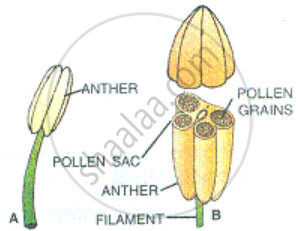Advertisements
Advertisements
Question
Observe any one flower and its various parts and describe it in your own words.
Solution

They different parts of a flower are:
- Androecium (male reproductive organ): The androecium consists of whorls of stamen. The stamen consists of the filament (long and slender stalk) and anther (bilobed structure). A typical anther is bilobed, which contains the pollen grains.
- Gynoecium (female reproductive organ): Gynoecium represents the female reproductive part made up of carpels. Carpel is made up of:
- Style − It connects stigma to the ovary.
- Stigma − It acts as a receptacle for the pollen grains.
- Ovary − It is the enlarged basal part on which style lies. Each ovary bears one or more ovules attached to cushion-like placenta. After fertilisation, ovules develop into seeds and ovary into fruit.
- Calyx (accessory organ bearing sepals): Calyx refers to the sepals.They are green in colour. They protect the plant in bud stage and also attract the insects for pollination.
- Corolla (accessory organ bearing petals): Corolla refers to the brightly coloured whorl of a flower. Individual unit of corolla is petals.Petals protect the inner essential organs (i.e., stamens and carpels) and attract pollinators since they are brightly coloured.
RELATED QUESTIONS
Given below are two figures (A and B) of a certain part of a flower. Study the figures carefully and answer the following question:

Which major organ of a flower does the figure A represent? What is the collective term for this organ ?
Given below are two figures (A and B) of a certain part of a flower. Study the figures carefully and answer the following question:

Can you state how the contents of the pollen sacs would come out?
Give the difference in the function between the following parts:
Filament and style
Differentiate between:
Marginal placentation and Parietal placentation
Give one example of the following:
Persistent calyx
Very Short Answer Type Question:
What are ovules?
Short Answer Type Question:
What do you mean by a complete and incomplete flower?
Bring few hibiscus flowers to the classroom. Distribute the flowers to children. Introduce the parts of the flower to them. Then, ask them to observe and feel the different parts of the flower and tell them to record their observation.
| Parts of flower | What is its colour? |
| Petal | |
| Sepal | |
| Pistil | |
| Stamen |
Male reproductive organ of the flower is
The largest flower in the world is found in the rain forests of ______.
